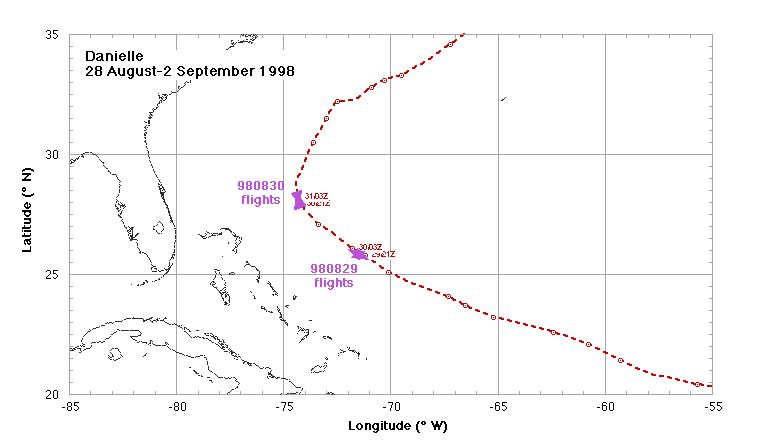

On 28 August the NOAA G-IVSP flew a synoptic surveillance mission in developing Hurricane Danielle as it passed just N of the Leeward Islands in support of NHC forecasts. On 29 August, NASA and HRD turned their attention to Hurricane Danielle which was rapidly approaching the Bahamas just N of Bonnie's cold wake. A Vortex Motion and Evolution Experiment using the two WP-3D aircraft and the NASA DC-8 was planned to map out the wind and thermodynamic structure of the storm within 160 nm of the center. The NASA DC-8 executed not only the VME experiment, but an inflow module up to 300 nm SE of the storm using the LASE to map vertical water vapor and aerosol profiles in a region SE of the storm. The NOAA G-IVSP was executing a synoptic surveillance mission with a pattern with dropsondes surrounding the immediate environment of the storm and extending as far N as 40 N latitude providing an excellent analysis of the storm environment.
Upon arrival in the storm vicinity the WP-3D lower fuselage radar revealed that Danielle was trying to form an eyewall. The developing eyewall was on the SE corner of a large hook shaped principal rainband curving around the center from 200 nm SE of the center through 80 nm N of the center to 50 nm NW of the center. During the mission the NE corner of the developing eyewall slowly wrapped around the center, and by the last pass through the center convection was growing all around the center.
GPS dropsonde (HSA) data format| Storm/Date | Aircraft (Duration) | Altitude |
Experiment | Comments (expendables) |
| Danielle | ||||
| 28 August | G-IV (9 h) GPS dropsondes |
41 kft |
Synoptic Surveillance | 31 sondes |
| 29 August | G-IV (9 h) N42RF (9 h) mission summary N43RF (9 h) mission summary WC-130 DC-8 (9 h) mission summary |
41 kft 12 kft 16-23 kft 5 kft 35-37 kft |
3-plane Vortex Motion and Evolution G-IV synoptic surveillance. WP-3D fly coordinated GPS sonde and dual Doppler pattern, N43RF 160 nm radius, N42RF 45 nm radius. AFRES recon. DC-8 3 160 nm radius legs to drop GPS sondes supporting WP-3D. Inflow pattern 300 nm SE of center |
|
HRD and NASA planned a four plane experiment in the core of Danielle on 30 August 1998 to see how the storm evolved. The DC-8 and ER-2 flew a butterfly pattern in the core followed by a zig-zag pattern at 250 nm radius S of the center to provide LASE profiles around the S semicircle of the storm. One WP-3D flew a modified air-sea interaction experiment with 100 nm radius legs to see what effect Bonnie's wake was having on Danielle, while the second WP-3D flew an eXtended Cyclone Dynamics eXperiment (XCDX). These data combined with flight-level data from the AFRES WC-130 and the NASA DC-8 are intended to map the storm's structure and dynamics as a follow-on to the VME conducted the previous day. The NOAA G-IVSP executed a synoptic surveillance mission in the immediate environment of the storm extending as far as 42 N providing an excellent analysis of the storm environment.
The eye appeared on WP-3D radar to be irregular with an eyewall composed of bands wrapping around it. N42RF reached the center at 2102 UTC, where two sondes where dropped, one at the flight level center and the other at the best estimate of the surface center. The observed profiles differed with splash pressures of 986 and 989 mb, not terribly different from the day before. On the final pass E-W across the center the eye appeared to be much more circular and regular. Two GPS sondes were deployed at the flight level center and both sondes fell at the axis of rotation. The soundings and splash pressures were essentially identical. The pressure had fallen 6 mb to 980 in 6.25 h, indicating significant strengthening of the storm during the mission.
| Storm/Date | Aircraft (Duration) | Altitude | Experiment | Comments (expendables) |
| Danielle | ||||
| 30 August | G-IV (9 h) N42RF (10 h) mission summary N43RF (8.5 h) mission summary WC-130 DC-8 (9 h) mission summary |
41 kft 16-23 kft 16-23 kft 10 kft 35-37 kft |
Extended Cyclone Dynamics (XCDX) and mod. Air-sea Interaction. G-IV synoptic surveillance. N42RF: XCDX 300 nm legs, N43RF: air-sea interaction 2 100 nm radius Fig. 4 AFRES recon. DC-8 2 100 nm radius Fig. 4 and inflow pattern 300 nm SE of center |
|
For information about NOAA Hurricane Field Program marks@aoml.noaa.gov
Updated Tuesday, 9 September 1998![]()